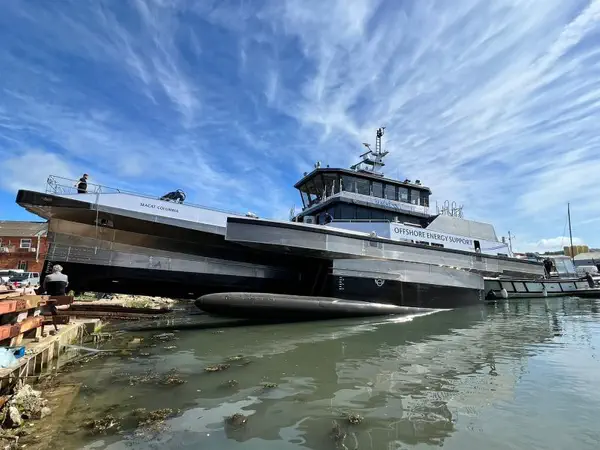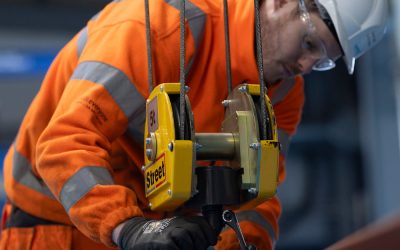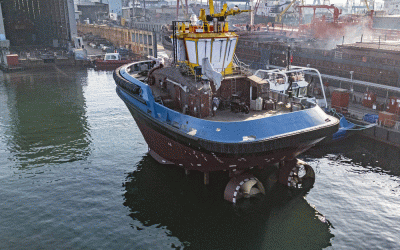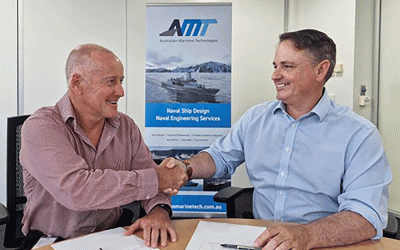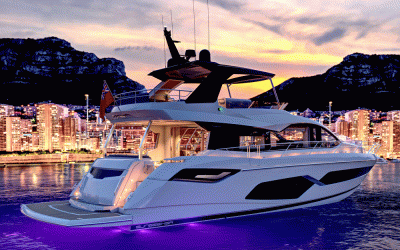Profiled at Seawork 2022, the offshore wind farm vessel Seacat Columbia doesn’t look that novel from the quayside – until you get a proper look at the far side of the boat, writes Stevie Knight. The BAR30-class vessel’s asymmetrical design may be surprising, “but the hull is 30% more efficient than a similar capacity cat for the same powertrain”, explains John Cooper of BAR Technologies. “It’s actually closest to a Polynesian outrigger canoe in shape,” adds partner Andy Page of Chartwell Marine, pointing out these craft historically made journeys with very little wind.
“Essentially, it has a longer, slender main hull – it has a 1.5m draught but, at 30m, it’s 5m longer than, for example, Seacat Weatherly,” says Cooper (see Significant Small Ships of 2020). Page adds: “Typically, cats have more volume forward to limit pitching, but this has a very fine entry.” Looked at front-on, there’s the narrow bow and, to the left, a slender strut supporting the torpedo shape of the swath-style outrigger: the effect is to reduce the total wetted area substantially, resulting in far lower resistance.
It yields enough hydrodynamic efficiency to pick up its beam further back, and the design bells out aft to allow both main engines and waterjets a place in the main body – and that can simplify propulsion layout. There’s also a fairly capacious 62m2 deck reaching across the whole to give a beam of 10.9m, with ample room for a couple of 10’ containers.
However, all this does require BAR Technologies’ ‘special sauce’ in the form of innovative hydrofoils, one of which is positioned just before the waterjets at the transom and the other mounted at the inboard side of the outrigger. These dynamic hydrofoils work collectively to control the roll and pitch of the boat, which reduces vertical acceleration by up to 70%: it is this seakeeping characteristic that will be of most interest to the crew in that “it feels much more like being on board a monohull”, Page explains. The foils also further reduce drag and increase fuel efficiency because, by levelling out the pitching motion, they ensure the boat is presented to the upcoming seas and waves in the most effective manner. This allows the twin MTU 12V8 engines and Kongsberg 853 waterjets to power the boat to its top speed of 31knots.
BAR Tech has also concentrated on slow-speed manoeuvring. Notably, the outrigger thruster, normally set perpendicular to the water flow, is positioned in-line, fore and aft, yielding a sturdy turning response. Further, Seacat Columbia can handle far higher seas – up to 2.5m Hs – both in transit and at the tower, rather than the more typical 1.5-1.75m Hs limit. It all makes for a convincing business case: “For example, at Dogger Bank, this type of boat will give you 10 days’ additional operation per year, taking in most of the windiest periods because that’s when you really need the maintenance,” says Page.
Built at Diverse Marine’s Medina Yard facility on the Isle of Wight, Seacat Columbia is likely to find its first charter around Scotland – but, according to Cooper “there’s also strong interest from floating farm developers and also from Asia, where the windfarms are much further out and you are dealing with big seas, needing a design with greater capability”. He adds: “The US especially is interested in growing its wind power sector: we can deliver a more effective vessel more cheaply than currently available over there, and of course all this impacts the MWh price of wind energy.”
But the future of this hullform is not just limited to wind farm maintenance: it makes for a very useful, stable platform with low running costs, so a 40m version could be used as a ferry, or “could even find a place as an unmanned geosurvey vessel for deeper waters”, Cooper concludes.
